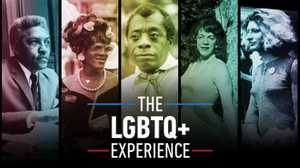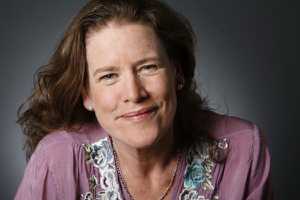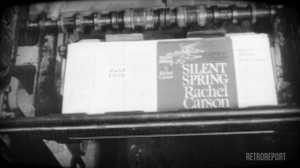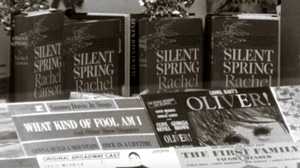Gathering History: The Digital Transgender Archive
People who research and write about transgender issues often face the challenge of finding primary sources. The Digital Transgender Archive seeks to change that. American Experience spoke with founder K.J. Rawson of the College of the Holy Cross about the collection and the importance of creating a historical record.

What is the Digital Transgender Archive?
The DTA is an online hub for transgender-related history. We wanted to make it easy for people to find primary source historical materials, so we created a one-stop shop that brings together material from dozens of collections from around the world.
What motivated you to create it?
When I was in graduate school I was doing research in transgender history and I found it shockingly difficult to find primary source materials. As I continued to do research in this area, and as I talked to other researchers and archivists, I learned that it was a widespread problem. I wanted to develop a tool that would start to alleviate some of those challenges.
Why is it so important to create that historical record?
There’s so much talk about transgender issues right now — there’s a lot of attention to it in the media, particularly. But there seems to be a kind of cultural amnesia; we’re talking about this as if it’s the first time it’s happening. So many people seem shocked by Caitlyn Jenner. But if you actually look to the historical record, we have American celebrities who lived outside gender norms dating back throughout our history. Christine Jorgensen, for example, was an absolute sensation in the 1950s. She had been a soldier and transitioned quite publicly. Afterwards, she continued to put herself out there, to make herself available as a public figure. We have a growing collection of materials related to her on the site.
Part of the purpose of the DTA is to make materials like that more accessible — both for people within trans communities and those outside of them. We want to help educate and help elevate popular discourse around these issues. We also want to give people a sense of their history who might not otherwise have it.
What were the challenges?
One of the biggest challenges is our scope — what do we include as transgender-related history? The term “transgender” is really recent; we need to be careful that we’re not using it anachronistically as we’re trying to identify materials from when the term didn’t exist.
Often with the historical record, we have these tiny fragments of people’s lives; we’re really just trying to pull all those fragments together and let researchers sort through them and figure out what’s happening there. So we’re always very careful to say that we’re not describing people as transgender; instead, we’re looking for evidence of transgender practices — things that document transgressions of gender norms.

Let’s talk about some of those things. You have materials that originate from within the community, as well as outside of it. We’ll start with the latter. Can you tell us about some of the newspaper clippings in the collection?
A lot of the clippings you can see on the site are documenting gender transgressions that were violating laws. In part, the newspapers were putting those stories forward as public interest. At the same time, the stories were serving to reinforce those laws. By publishing these cases of people who’ve been caught doing something considered immoral and illegal, you’re also sending a message to other people not to do those things.
Even in these types of newspaper clippings, it’s very common to have quotes from self-identified trans people as part of the story. But the framing of that story and the way it’s narrated is very rarely in the control of the people who are being featured. It’s definitely a tone of shock and awe. You’ll get expected things like “former soldier turns into a blond beauty,” or “father of three becomes a woman.” The authors will often take a conventional icon of masculinity and really emphasize how shocking it is that that person is now female.
You can see how a culture is trying to grapple with the unthinkable. They’re trying to explain it away or find ways to understand it in order to become more comfortable with it. To mainstream society, it couldn’t possibly be that a person would just do this, so there has to be some other reason.
How are the publications that originate from within the community different from the ones you find in the mainstream media?
Those are really the spaces where you’re going to find trans people writing letters to the editor, first-person accounts, and editorials where people are talking about their own experiences.
We actually have trans-specific publications that were published by trans people starting in the 1950s in the U.S. If you talk to researchers who’ve spent any time in the archives, Drag Magazine is one of those publications that frequently draws people in — it’s a glossy, really well-produced magazine. My understanding is that Drag was part of a very active community that was based in New York City out of Lee Brewster’s boutique. Brewster was an activist who played a central role in drag communities. At his store, you could buy clothing, maybe get some tips on makeup — it was a place where this community converged. The publication was part of a very active and enlivened community.
And these communities didn’t just exist in New York City; in fact, they bridged international borders. That’s actually one thing that surprised me. We have a small collection of materials from South Africa, including a newsletter. In this newsletter, you see references to other publications that we have on the site that were published in the U.S. or in Canada — one of them was even published in Ireland. What that shows is that starting in the late '70s and '80s, this really international community was starting to connect. That really blew my mind. Of course, I’m a child of the internet, so I have a limited understanding of the ways people were connecting globally prior to the internet, but they really were making close connections and these newsletters document that in interesting ways.

You also have documentation of more intimate connections, like the collection of correspondence between Lou Sullivanand Ben Power. Who were they?
Lou Sullivan is generally credited as being the founder of the female-to-male movement in the U.S. He died in 1991 after spending his life advocating for people who are female-to-male and increasing the visibility of this community. He also identified as a gay man, so he experienced a lot of difficulty in transitioning because that just wasn’t understood, it wasn’t an option. If, as a woman, he was attracted to men, why would he ever transition? Even into the ‘70s and ‘80s, gender and sexuality are completely entangled. He fought for trans and gay issues and their intersections until his dying day. He had hundreds of correspondence relationships with people throughout the world where he was supporting them and encouraging them to have the courage to transition if that’s what they wanted to do.
At the time, Ben Power was organizing a group called the “East Coast F to M” group. Through his role there, and as the curator of the Sexual Minorities Archives, he had solicited a booklet from Lou — it was called “Information for the Female to Male Crossdresser and Transsexual” — which is also on the site. Their correspondence continued after Ben received the booklet, and they became friends. It was a long-distance friendship; Lou was based, at least in the last few decades of his life, in San Francisco and Ben was in Massachusetts. The letters document their friendship and the ways in which Ben is coming to understand himself — in part through Lou’s publications and their correspondence.
I think the passion and intimacy that you’re able to read in these letters documents the powerful ways that communities were forming over these shared experiences that were happening thousands of miles apart.
What parts of the collection have people responded to the most?
Alison Laing is a popular figure on our site –– she was an activist who had a hand in everything. She lived her life moving back and forth between male and female roles. She is very beloved, and I hear more about about her collections than any others on the site, particularly some of her early photographs starting in the 1950s. The photographs are beautifully taken and full of emotion. In many of them, she appears to be traveling to iconic American sites. One of the shots is of her leaning up against a cannon, I think somewhere in rural Pennsylvania. She’s dressed in typical 1950s wear and it’s clear that she’s revelling just in being out in public and being able to present herself in this way.

Who has been using the archive? Who do you expect to use it in the future?
We’ve actually heard from a lot of educators that they’ve been using the DTA in their classrooms — not just in college settings, but in high schools, too, which surprised me. Through some of those contacts, we get feedback from kids as young as 14 or 15 who are gender non-conforming, saying this is the first time they’ve been able to read this kind of thing and it’s really changing their life.
Once in awhile, we’ll also get letters from people around the world saying that they found the site, they don’t know anyone else in the world who’s transgender, and this is helping them to feel connected. For us, those are some of the most inspiring stories that we hear and they help us to keep pushing to build and grow the collection because it really does seem to be touching people’s lives.
This interview has been edited and condensed for clarity.
To explore the DTA’s collection, visit digitaltransgenderarchive.net

Explore our new collection featuring a selection of films documenting the LGBTQ+ Experience — along with articles, digital shorts, and original features exploring America’s continued struggle with democracy, inclusion and justice for LGBTQ+ Americans, and celebrating the contributions of the LGBTQ+ community to the American story.









